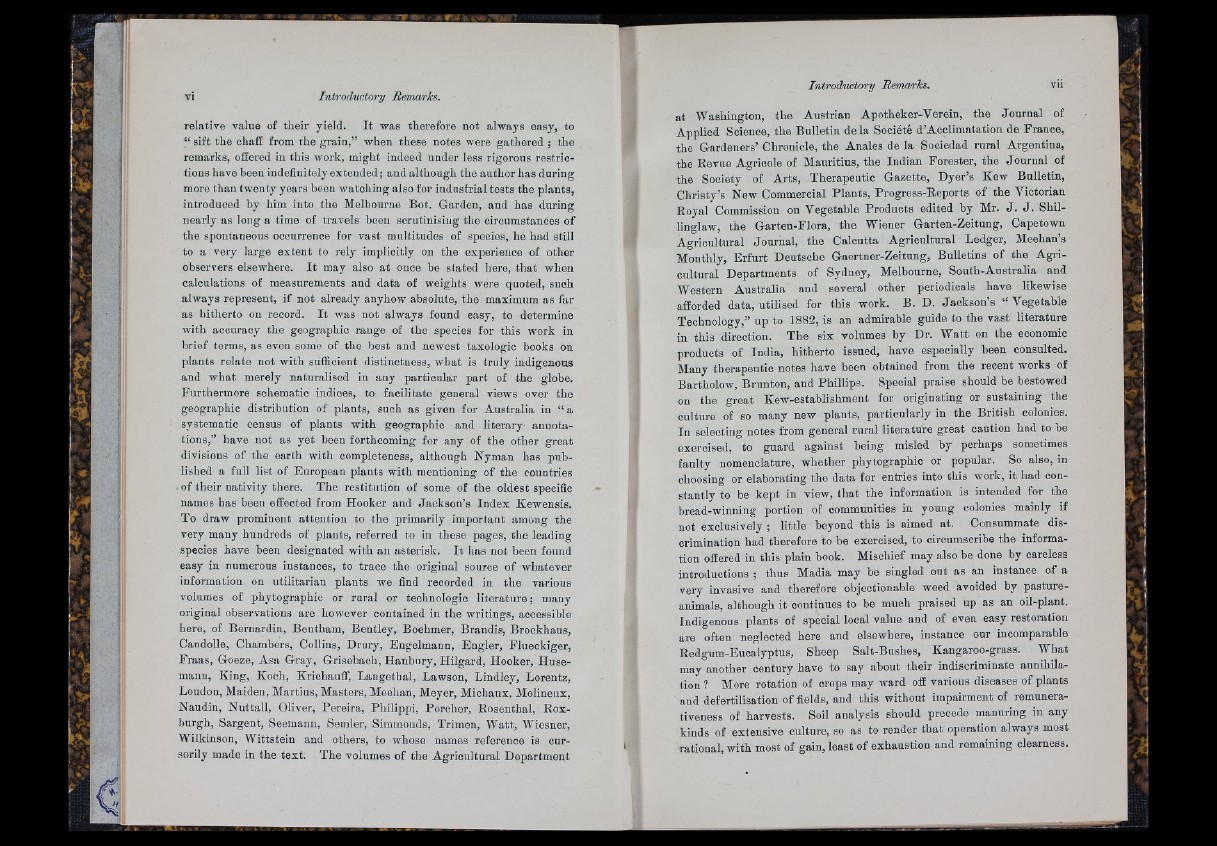
as
Introductory Remarles.
relative value of their yield. I t was therefore not always easy, to
“ sift the chafi from the grain,” when these notes were gathered ; the
remarks, offered in this work, might indeed under less rigorous restrictions
have been indefinitely extended; and although the author has during
more than twenty years been watching also for industrial tests the plants,
introduced by him into the Melbourne Bot. Garden, and has during
nearly as long a time of travels been scrutinising the circumstances of
the spontaneous occurrence for vast multitudes of species, he had still
to a very large extent to rely implicitly on the experience of other
observers elsewhere. I t may also a t once be stated here, th a t when
calculations of measurements and data of weights were quoted, such
always represent, if not already anyhow absolute, the maximum as far
as hitherto on record. I t was not always found easy, to determine
with accuracy the geographic range of the species for this work in
brief terms, as even some of the best and newest taxologic books on
plants relate not with sufficient distinctness, what is truly indigenous
and what merely naturalised in any particular part of the globe.
Furthermore schematic indices, to facilitate general views over the
geographic distribution of plants, such as given for Australia in “ a
systematic census of plants with geographic and literary annotations,”
have not as yet been forthcoming for any of the other great
divisions of the earth with completeness, although Nyman has published
a full list of European plants with mentioning of the countries
of their nativity there. The restitution of some of the oldest specific
names has been eilected from Hooker and Jackson’s Index Kewensis.
To draw prominent attention to the primarily important among the
very many hundreds of plants, referred to in these pages, the leading
species have been designated with an asterisk. I t has not been found
easy in numerous instances, to trace the original source of whatever
information on utilitarian plants we find recorded in the various
volumes of phytographic or rural or technologic lite ra tu re ; many
original observations are however contained in the writings, accessible
here, of Bernardin, Bentham, Bentley, Boehmer, Brandis, Brockhaus,
Candolle, Chambers, Collins, Drury, Engelmann, Engler, Flueckiger,
Fraas, Goeze, Asa Gray, Grisebach, Hanbury, Hilgard, Hooker, Huse-
manu. King, Koch, Krichauff, Langethal, Lawson, Bindley, Lorentz,
Loudon, Maiden, Martins, Masters, Meehan, Meyer, Micbaux, Molineux,
Naudin, Nuttall, Oliver, Pereira, Philippi, Porcher, Rosenthal, Roxburgh,
Sargent, Seemann, Semler, Simmonds, Trimen, Watt, Wiesner,
Wilkinson, Wittstein and others, to whose names reference is cursorily
made in the text. The volumes of the Agricultural Department
T
i
at Washington, the Austrian Apotheker-Verein, the Journal of
Applied Science, the Bulletin de la Société d’Acclimatation de France,
the Gardeners’ Chronicle, the Anales de la Sociedad rural Argentina,
the Revue Agricole of Mauritius, the Indian Forester, the Journal of
the Society of Arts, Therapeutic Gazette, Dyer’s Kew Bulletin,
Christy’s New Commercial Plants, Progress-Reports of the Victorian
Royal Commission on Vegetable Products edited by Mr. J . J . Shil-
linglaw, the Garten-Flora, the Wiener Garten-Zeitung, Capetown
Agricultural Journal, the Calcutta Agricultural Ledger, Meehan’s
Monthly, Erfurt Deutsche Gaertner-Zeitung, Bulletins of the Agricultural
Departments of Sydney, Melbourne, South-Australia and
Western Australia and several other periodicals have likewise
afiorded data, utilised for this work. B. D. Jackson’s “ Vegetable
Technology,” up to 1882, is an admirable guide to the vast literature
in this direction. The six volumes by Dr. Watt on the economic
products of India, hitherto issued, have especially been consulted.
Many therapeutic notes have been obtained from the recent works of
Bartholow, Brunton, and Phillips. Special praise should be bestowed
on the great Kew-establishment for originating or sustaining the
culture of so many new plants, particularly in the British colonies.
In selecting notes from general rural literature great caution had to be
exercised, to guard against being misled by perhaps sometimes
faulty nomenclature, whether phytographic or popular. So also, in
choosing or elaborating the data for entries into this work, it had constantly
to be kept in view, th a t the information is intended for the
bread-winning portion of communities in young colonies mainly if
not exclusively ; little beyond this is aimed at. Consummate discrimination
had therefore to be exercised, to circumscribe the information
offered in this plain book. Mischief may also be done by careless
introductions ; thus Madia may be singled out as an instance of a
very invasive and therefore objectionable weed avoided by pasture-
animals, although it continues to be much praised up as an oil-plant.
Indigenous plants of special local value and of even easy restoration
are often neglected here and elsewhere, instance our incomparable
Rodgum-Eucalyptus, Sheep Salt-Bushes, Kangaroo-grass. What
may another century have to say about their indiscriminate annihilation
? More rotation of crops may ward off various diseases of plants
and defertilisatlon of fields, and this without impairment of remunerativeness
of harvests. Soil analysis should precede manuring in any
kinds of extensive culture, so as to render that operation always most
rational, with most of gain, least of exhaustion and remaining clearness.